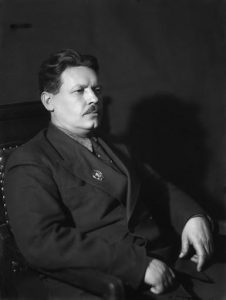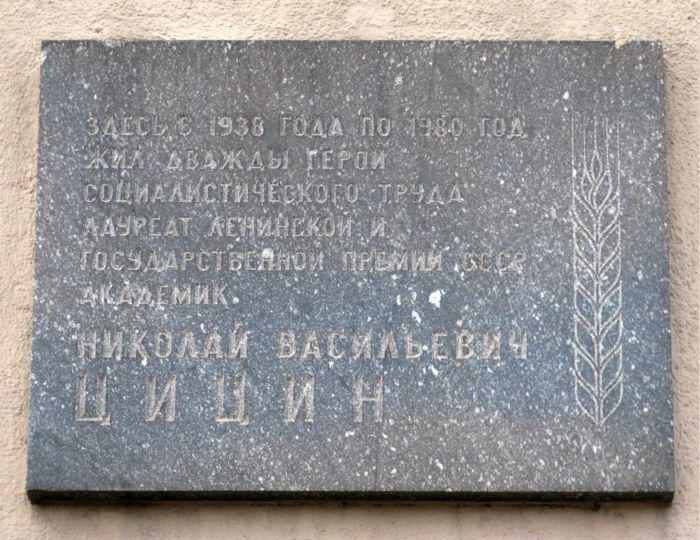Nikolay Vasilyevich
Tsitsin
1898-1980

Nikolay Vasilyevich Tsitsin was the Academician of the All-Union Academy of Agricultural Sciences named after V.I. Lenin, director of the Main Botanical Garden of the USSR Academy of Sciences. He was born in Saratov in a peasant family. He finished elementary school. As a teenager, he worked at a factory in Saratov. During the Civil War, he was a military commissar, he participated in the defence of Tsaritsyn (now it is Volgograd) and the battles on the Southern Front, defended the Soviet Republic. After the war in Saratov, he graduated from the Faculty of Labor at the University. In 1923-1927 he studied at the Saratov Institute of Agriculture and Land Reclamation. After graduating from the Institute in 1927-1932 he worked at the All-Union Research Institute of Grain Farming of the South-East as a researcher. From the very beginning, N.V. Tsitsin was interested in the problem of creating more productive varieties of the main food crop – wheat – on the basis of remote hybridization. He crossed wheat with wheatgrass and for the first time received a wheat-wheatgrass hybrid. He widely involved wild and cultivated plants in crossing, which had passed independent evolutionary paths that determined their genetic isolation. The research, carried out by the scientist in this direction, made it possible to create new varieties of plants. Since 1932, N.V. Tsitsin worked as the head of the laboratory of wheat-wheatgrass hybrids at the Omsk zonal Experimental Station, later reorganized into the Siberian Research Institute of Grain Farming (in 1936-1938 – the director of the Institute). He became the Doctor of Agricultural Sciences (1936). Here the scientist created medium-early (with a shorter growing season) varieties of wheat-wheatgrass hybrids, characterized by high yields and a complex of other economically valuable traits. At the same time, new varieties of wheat were created, having a branched structure of the ear. Before that, only forms of spring hard branched wheat existed in nature. The scientist managed to create varieties of winter soft branched wheat, that is, forms that previously did not exist in nature at all. One of Tsitsin’s pioneering works was experiments on the creation of multi-grain forms of wheat with particularly high productivity. In 1938-1949 and in 1954-1957 N.V. Tsitsin was the director of the All–Union Agricultural Exhibition in Moscow; in 1938-1948 – the Chairman of the State Commission for Variety Testing of Cereals, Oilseeds and Herbs; in 1940-1949 – the Director of the Research Institute of Grain Farming of the Non-Chernozem Zone of the USSR; in 1940-1957 – the Head of the Laboratory of Remote Hybridization of the Academy of Sciences of the USSR, in 1938-1948 – the Vice-president of the All-Union Academy of Agricultural Sciences named after V.I. Lenin (VASHNIL). He was a member of the CPSU (b)/CPSU since 1938. In the post-war years N.V. Tsitsin created intermediate constant (stable in offspring) forms of wheat with a high protein content and competing in yield with the best standards of this crop. For the first time in the history of breeding and genetic science, he created a completely new type of wheat plant of great scientific and practical importance — perennial wheat, which he named Triticum agropynotriticum. Under the leadership of N.V. Tsitsin, all landscape and construction work on the development of the VSHV took place/VDNKH of the USSR and GBS. He was the initiator of organizing expeditions around the country to collect plants for the botanical garden. Since 1947, Tsitsin had been collecting a scientific library, in the funds of which already in 1952 there were 55 thousand books, including the rarest copies of the XVI-XIX centuries in Russian and foreign languages. Since 1948, Tsitsin began publishing the Bulletin of the Main Botanical Garden. Of the 200 bulletins published from the 1st to the 120th, he was the responsible editor himself. Under his leadership, an arboretum was created on 75 hectares, one of the largest in Europe. During its existence, 2,500 species of woody plants have been tested in it. Of these, 1800 were selected as quite stable, and of these, in turn, about 600 are recommended for landscaping Moscow. In 1952, on the initiative of N. V. Tsitsin, a network of botanical gardens of the USSR was created, and the Main Botanical Garden of the USSR Academy of Sciences became a kind of national coordinating and methodological center. In the same year, the greenhouse was opened. By 1953, Tsitsin had completely completed the exposition of the flora department, and by 1954, by the second birthday of the VSHV/VDNH, the garden of continuous flowering, the garden of coastal plants and the collection rose garden had been finally completed. In the village of Snegiri in the Istra district of the Moscow region, Tsitsin organized an experimental garden farm on almost 1.5 thousand hectares. On July 28, 1959, the Botanical Garden was opened to visitors. By the 1970s, all the main expositions of the garden had been finally completed, as well as collection sites of geographical landscapes in the flora department had been created. The garden under the leadership of N.V. Tsitsin became one of the largest in Europe. In his collections there were more than 20 thousand plant taxa (about 17 thousand were exhibited).
Address: Moscow, Serafimovicha str., 2

